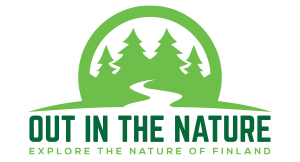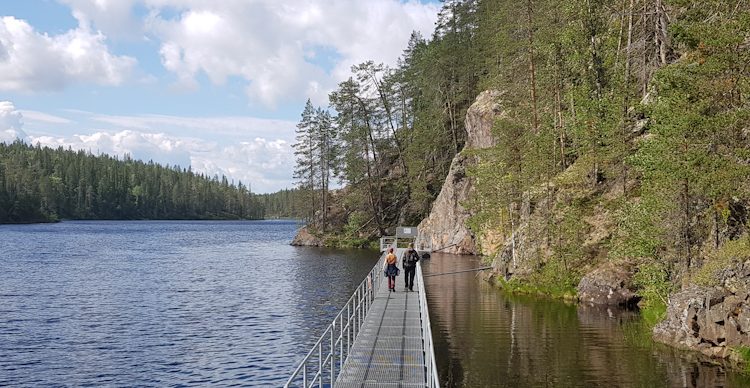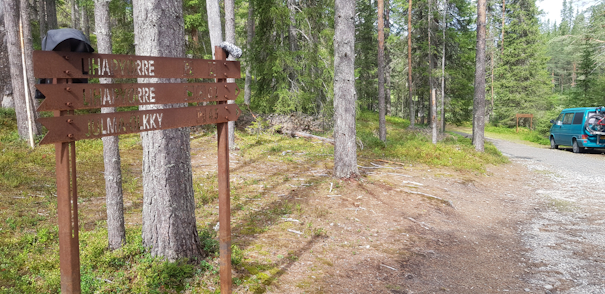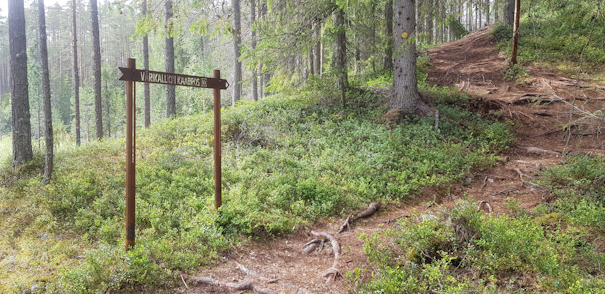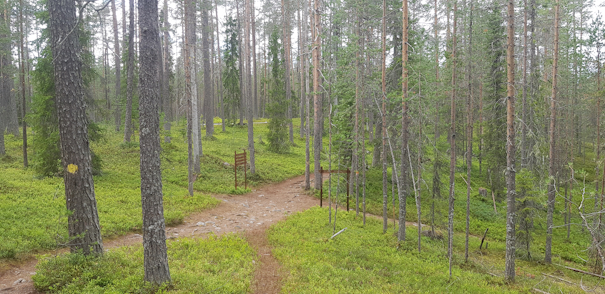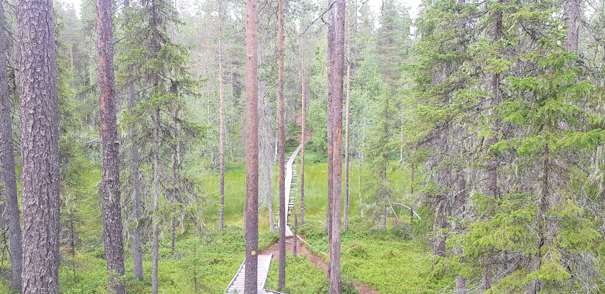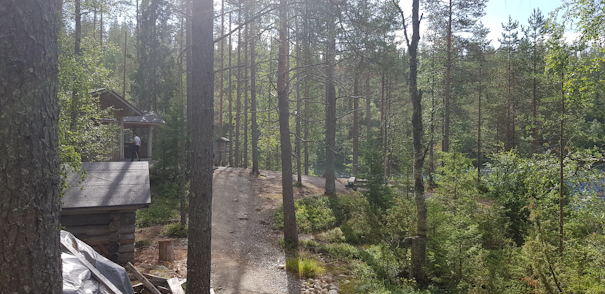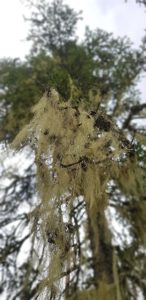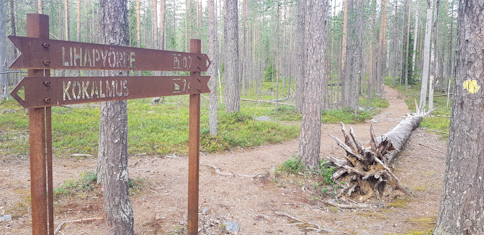One of the most spectacular places to experience a connection with our human history is at Hossa National Park in Suomussalmi. We had decided to hike the popular yet moderately demanding 8km (4.9mi) long Värikallion kaarros trail in order to see the famous rock paintings. Before we left on our hike, we visited the Hossa information centre, and then drove to the trail head. It was late August so the weather was still warm but sadly, the beautiful autumn colours hadn’t yet arrived in this pine forest.
Värikallion kaarros trail
After some driving from the visitor centre, we found the trail head and the large parking lot. We had decided to go round the circular trail counter-clockwise. Once we got onto the trail, it was a bit uneven with roots. However, the further we walked, there were clearly signs of the trail having been evened with gravel. You can just stroll happily and enjoy the deep and dense forest landscape in front of you.
Of course, as we knew in advance, Värikallion kaarros is anything but flat. We hit the first set of stairs after a few kilometres of walking. At this stage, they only caused mild huffing and puffing, nothing more serious. Soon after, we hit a larger crossroads where several paths intersect. A word of warning: make sure you remember which path you are following so that you don’t get lost here.
Soon, we hit some swampy bits with duckboards helping to cross them. We walked past the Ala-Ölkky lean-to with the exception of using the toilet facilities. But as soon as we made it past some lovely ponds, the trail began to wind up the hill.
We were making our way on top of the cliffs backing up to a beautiful deep blue canyon lake. It was essential to keep a good eye on the trail so that we didn’t get too close to the edge – none of us felt like falling down tens of metres into the lake.
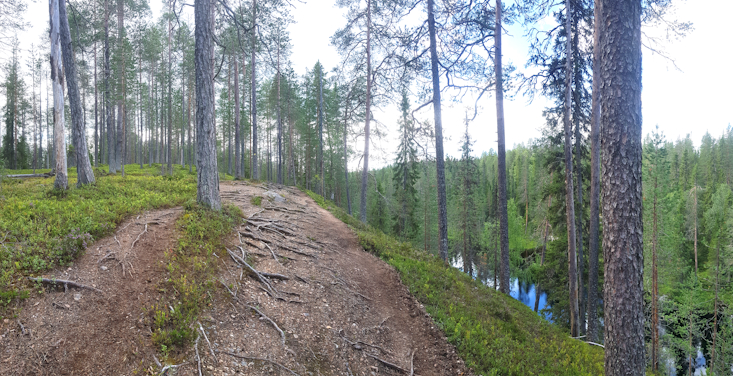
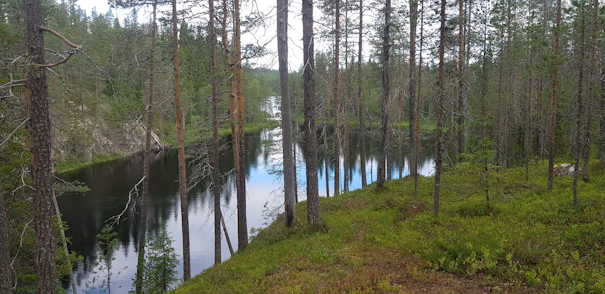
After a good 1,5h of trecking, we finally made it to the rest area next to the rock art cliffs. Perfect time to take a rest, eat sandwiches and enjoy the beautiful sunshine across the lake.
Incredible rock art at Värikallio
The circular route at Hossa called Värikallion kaarros takes you to incredible rock art painted on the side of a cliff. Experts have estimated that these rock paintings were made in the Stone Age, approximately 3500-4500 years ago. They were painted while the painters were on a boat or perhaps the cold winter and sturdy ice was used.
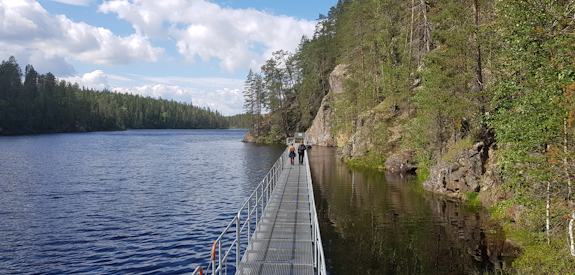
Even in ancient times, this waterway was important to people, so this is one of the reasons why they chose this cliff side to paint on. Experts have also thought that one important aspect of why this spot was chosen was the echo: many places with rock paintings have booming echoes. One explanation for their painting is shamanism, another points towards hunting magic, a third one to requests of fertility and safety in child birth.
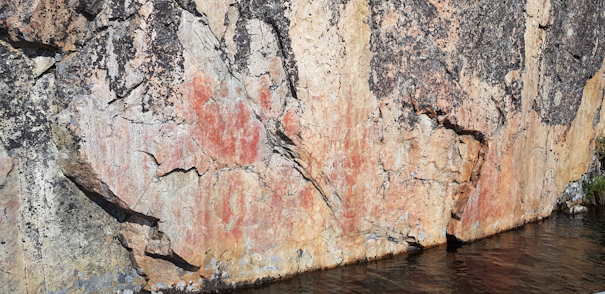
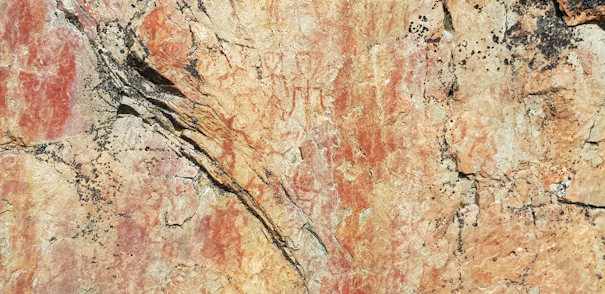
These kind of stick-figure paintings of moose are rare in Finland, and haven’t been seen anywhere else. The same goes for the human figure with a triangle-shaped head. The paintings have been made using red or yellow soil, which has been heated up to create iron-rich clay. This has then been mixed with blood, fat, or egg yolk.
Hossa keeps you fit for sure
After spending a long time deciphering the rock art, we eventually began to make our way back to Lihapyörre. We had about 2,5-3km to go, and the trek began with… stairs. Up from the lake to the top of the cliffs. A true workout, I tell ya.
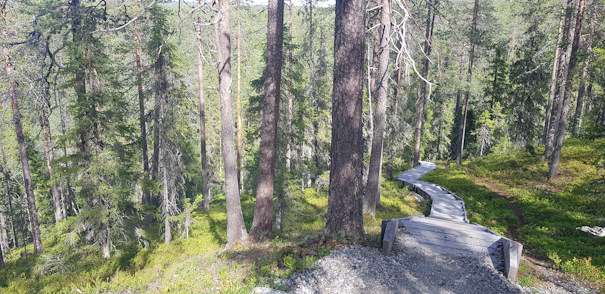
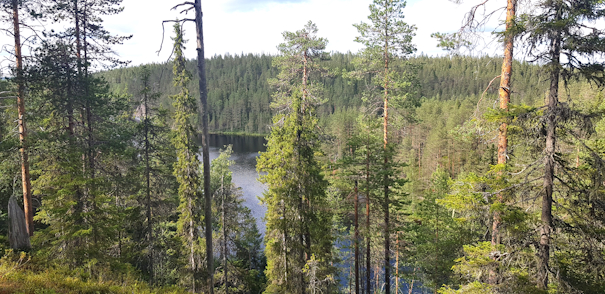
What you immediately notice at Hossa is the incredible air quality. Massive old pine trees are heavy with beard lichen more commonly known as “old man’s beard” (naava in Finnish).
If you’re not familiar with the meaning of beard lichen, it means that the air is very pure. Beard lichen only grows on trees in areas where the air quality is exceptionally good.
You may wonder why we had the energy to concentrate on lichen? Well, we had to sit down after the stairs on a fallen log so we had plenty of time to check out the surrounding greenery.
As our thighs were shaking after the stairs, we were happy to discover the rest of the way to Lihapyörre was relatively flat. A quick stretch session is recommended when you get back to your car or tent. So, even though 8km doesn’t sound too bad, the terrain is still uneven at times plus there is a lot of ascending and descending to do. Make sure you are fit enough to tackle this trail and take plenty of breaks.
Directions to Hossa National Park
How to get there: Hossa National park is vast but the best place to start is the nature/visitor centre. The most convenient way to get close is by car. Type in Hossan luontokeskus on your navigator. Alternatively, you can type the exact address Jatkonsalmentie 6, 89920 Suomussalmi.
- Car: There are large carparks at the Hossa nature centre.
- Bicycle: You can cycle to the site but you have to share the road with cars.
- Public transport: There is a bus that takes you all the way to Hossa but it only runs between weeks 23-39 (June-mid September). You can check timetables here. At all other times, there is a bus that takes you to Peranka village 40km away from Hossa. Check for timetables here and remember that you will have to find a way to get to Hossa from Peranka.
Värikallion kaarros trail head: The trail we chose departs from a place called “Lihapyörre”, which has a parking area. The road to the parking area diverges from Pistonlehdontie 194, but we found it by typing Värikallion kaarros on our navigator. If you have any doubts, you should visit the visitor centre for guidance to make sure you find the right place like we did.
Accessibility: The national park is not very accessible. The nature centre is accessible but the paths may pose problems for very young children or those with limited mobility.
Facilities: Hossa National Park is open at all times. The Hossa nature centre is usually open between 10am-4pm except for in January and February when it’s closed. If you walk the Värikallion kaarros route, there is an outhouse, a cooking hut, a wood shed, and a circular firepit at Somerjärvi lake. If there is forest fire warning on, you can not use this firepit as it doesn’t have a flu (ventilation shaft) and it’s on the ground.
When to go: The easiest time to visit is when there is no snow because deep snow may cover dangerous pits on the ground.
Maps: Check out trail maps from National Parks’s official website.
Sights nearby
While you are in the area, check out the Silent People art installation, the Musical Forest at Suomussalmi, Riisitunturi fell and its incredible views, Hepoköngäs waterfall, the tallest waterfall in Finland. You should also check out the Kajaani tar channels and old castle ruins as well as Rokua National Park.
